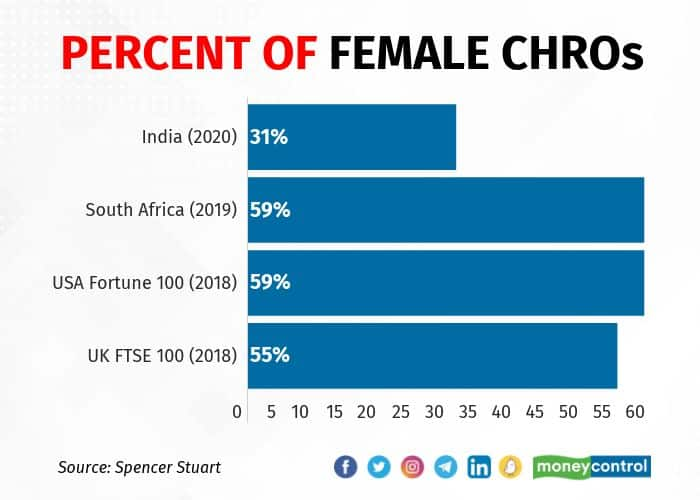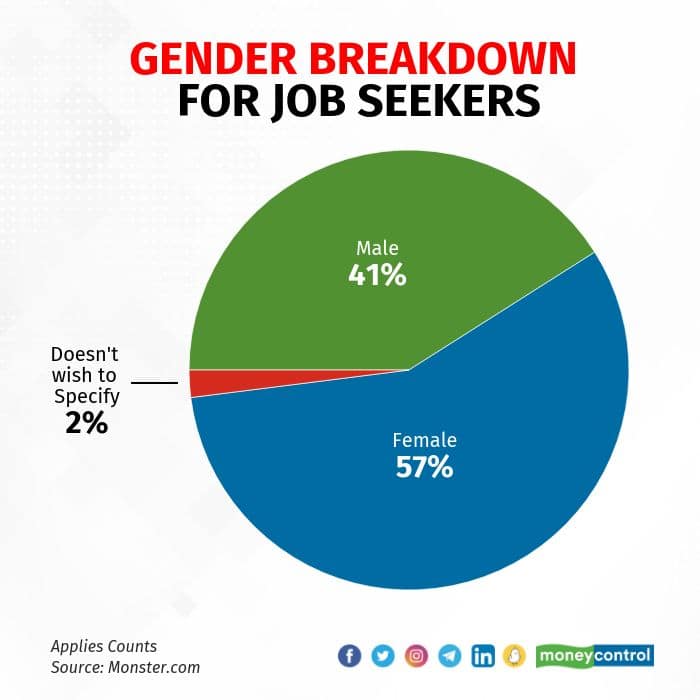



Ensuring diversity has become a key responsibility of human resource teams in companies and there has been some degree of success in this endeavour, especially after the pandemic.
However, organisations across sectors have been battling with a perception in society and boardrooms alike that the HR function is largely a woman’s job, even though female talent hardly dominates leadership positions.
In 2020, executive search firm Spencer Stuart looked at the profiles of chief human resource officers in 160 of India’s leading companies and found that, contrary to the general perception, only 31 percent of them were women. That was lower than South Africa’s 59 percent in 2019.
India Inc appears to have identified the problem of skewed diversity and is working to resolve it. Executive search firm KNR found more than 80 percent of the companies in non-tech spaces like manufacturing, chemicals, pharma and medical devices looked for female talent for recruiting roles.
Its research also showed that the top 100 Indian and global MNCs in the country strived to attain gender balance while hiring for HR roles at all levels.
Another staffing firm, Spectrum Talent Management, found the current hiring scenario across 15,000 applicants and placements was close to 60:40 in favour of women. The designations vary, but they are primarily at junior and mid-levels because the traction at senior levels is minimal.

Some companies told Moneycontrol they don’t deliberately look for females while seeking HR candidates, but they do focus on ensuring gender balance in the department.
Poonawalla Fincorp has a female-to-male ratio of 30:70 in its HR team, while UTI Asset Management has a 26:74 ratio. However, both companies are focused on building a balanced team, not just from the gender perspective, but also to address overall diversity and inclusivity ratios.
According to Smita Mitra, head of HR at Poonawalla Fincorp, there appear to be more female employees than males in HR teams in recent times.
“This will open a plethora of opportunities for the female workforce and boost their morale,” she said, adding that it was a good thing.
Mitra said HR professionals need to be empathetic and good at multitasking, and women take this role naturally, which makes them a better fit for the HR function.
“Females, by natural instinct, have an optimal blend of compassion and assertiveness, which is an important aspect of people skills. Therefore, they make good HRs,” said Indranil Choudhury, head of HR at UTI AMC.
At tax advisory firm Grant Thornton Bharat, 57 percent of the HR team consists of females. Chief people officer Satya Jha said anyone can play the HR role, irrespective of gender.
“Some may feel that women, in general, are naturally more empathetic, but that is the exact unconscious bias that we need to overcome and not label the job responsibilities to a gender,” he said. “Diversity is required anywhere there is a lack of balanced representation. Why should it be any different in HR?”
Talent supply
The matter of gender balance extends even to students of HR courses in management colleges. For its PGP-HRM course for 2020-22, the Indian Institute of Management Indore has 19 women participants in a batch of 37.
The proportion of women candidates is increasing every year and currently, in some of the top management institutes of the country, this representation has gone up to more than 50 percent, said Kamal K Jain, a professor at IIM Raipur.
“So, it’s not only about women CHROs, it’s more about the availability of a larger pool of women candidates in general and HR in particular,” he added.
Job portal Monster India said employers do not share gender preferences while posting job roles. However, a gender breakdown of 223,314 people who applied for HR roles in May-July showed there were more women candidates.

Does HR come naturally only to women?
The tendency to recruit more females at this stage in the evolution of Indian companies, even if it is aimed at attaining a gender balance in the workspace, may have unnerved the men folk. However, experts said there is no threat to male talent.
Omita Sharma, an HR and culture leader, said women find themselves to be more compliant with and adept in managing people, developing solutions, and taking decisions to craft business growth.
“But this doesn’t mean that men are being neglected or there is an unequal or imbalanced gender diversity ratio due to any bias or stereotypes,” she asserted.
Skill sets and the overlap between women’s natural talents and HR skills are significant, but using the women-are-naturally-more-nurturing defence is somewhat “misinformed” and a “sexist argument,” said Vishal Sharma, head of HR – Asia at Aditya Birla Chemicals.
“HR is a demanding field, and professionals do a lot more than just take care of employees,” Sharma said.
HR leaders said there is a lot of pressure on companies to meet diversity targets. However, they said instead of striving for diversity in key decision-making positions, some companies tend to implement these goals largely in support functions.
Amit Sharma, an HR leader working in a multinational IT company, said it is extremely common for companies to fill positions with the caveat of ‘diverse candidates only,’ which needs to be interpreted as women only.
The subtle messaging that it is easier to make it to leadership roles as a woman will drive away male talent further, he said, adding that with fewer male HR leaders, the concerns of men in the workforce tend to get neglected.
Sharma cited the example of maternity benefits. He explained that in one of his previous organisations, he was the only man – and a new father – in a team of 10. But there was never any consideration that Sharma might find it difficult to settle down, “which would have been the case if the gender ratio was reversed.”
“Companies have been so thoughtful that there are tie-ups with vendors to ensure fresh breast milk reaches their children when they are on tour. However, paternity support by most organisations is abysmally low,” he observed.
When Gaurav Kapil completed his PG in HR 15 years ago, the female-to-male ratio in his batch was 2:1, which is why there are more females in the market now.
“With this, I am not surprised that similar ratios are depicted in leadership positions in the corporate world today,” said Kapil, an HR lead at B2B trade platform Udaan.
However, while appointing a female HR head might be an easy way out, it does not paint a true picture of gender diversity at the management level, he pointed out. At one stage of his career, Kapil said he could not find many female takers for core HR operations/ground HR roles, in contrast to the general perception.
Anurag Shrivastava, CEO of HRNEXT, who has specialised in hiring HR professionals since 2006, said there is no trend of favouring women in hiring for HR roles at any level.
“Organisations have an HR talent pipeline for leadership that comes primarily from 6-7 elite business schools specialising in HR functions,” he said.
However, Shrivastava observed that the representation of women at the CHRO level is less than in the pipeline because of mid-career dropouts or taking up career paths that do not lead to CXO roles.
Shrivastava explained that CHROs tend to be those who have gone through a general management path as HR business partners rather than those who are specialists in learning, organisation development or rewards.
“In that sense, it also becomes a conscious choice,” he said.
Discover the latest Business News, Sensex, and Nifty updates. Obtain Personal Finance insights, tax queries, and expert opinions on Moneycontrol or download the Moneycontrol App to stay updated!
Find the best of Al News in one place, specially curated for you every weekend.
Stay on top of the latest tech trends and biggest startup news.